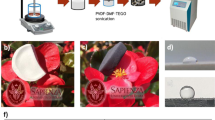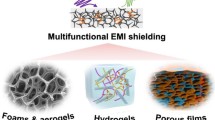Abstract
Graphene aerogels (GAs) are prevailing to solve electromagnetic interference (EMI) issues in next-generation electronic devices. However, the practical EMI shielding application of lightweight GAs is still a great challenge because of their structural instability when confronted with complex conditions. Here, we report a class of ultra-stable GAs with excellent and reliable EMI shielding performances. The GA (ρ = 3.7 mg cm−3) with face-to-face stacked structure exhibits a high shielding effectiveness (SE) of 64.1 dB at the thickness of 1 mm. The specific EMI SE reaches 173,243 dB cm2 g−1, far beyond the previous carbon-based materials. Meanwhile, the structural stability endows the GAs with outstanding resistance to external stimuli, such as mechanical deformation, extreme temperature, flame and underwater environments. The intrinsic conflict of low density and oversized volume is solved by vacuum bagging without structure and performance loss. Our GAs have paved the way for the practical EMI shielding materials and greatly broadened the applied scenes, such as aerospace, warcraft and ocean fields.

摘要
石墨烯气凝胶(GAs)在解决下一代电子器件电磁屏蔽污染方面引起了广泛关注. 但是, 由于超轻石墨烯气凝胶在复杂环境中结构不稳定, 其在电磁屏蔽的实际应用中仍面临巨大的挑战. 在此, 我们提出一类机械结构稳定的石墨烯气凝胶, 其展示出优异可靠的电磁屏蔽性能. 这类气凝胶呈现出面面堆叠的结构, 在密度ρ = 3.7 mg cm−3, 高度1 mm时, 电磁屏蔽效能可达到64.1 dB, 比电磁屏蔽效能达到173,243 dB cm2 g−1, 远超现有报道的碳基材料. 同时, 石墨烯气凝胶具有优异的环境适应性, 在机械形变、 极端温度、 燃烧及水下等环境中均可保持性能稳定. 此外, 制备的石墨烯气凝胶可通过真空袋装工艺进行包装运输, 解决了超轻材料实际应用中低密度与大体积的矛盾, 且在这一极端变形过程中材料结构和性能均未产生破坏. 该研究为石墨烯气凝胶电磁屏蔽材料的实际应用铺平了道路, 且拓展了其实际应用场景, 比如航天、军事战机及海洋领域.
Similar content being viewed by others
References
Chen Y, Zhang HB, Yang Y, et al. High-performance epoxy nanocomposites reinforced with three-dimensional carbon nanotube sponge for electromagnetic interference shielding. Adv Funct Mater, 2016, 26: 447–455
Shu JC, Cao WQ, Cao MS. Diverse metal-organic framework architectures for electromagnetic absorbers and shielding. Adv Funct Mater, 2021, 31: 2100470
Huang Y, Li N, Ma Y, et al. The influence of single-walled carbon nanotube structure on the electromagnetic interference shielding efficiency of its epoxy composites. Carbon, 2007, 45: 1614–1621
He P, Cao MS, Cao WQ, et al. Developing MXenes from wireless communication to electromagnetic attenuation. Nano-Micro Lett, 2021, 13: 115
Huang Z, Chen H, Huang Y, et al. Ultra-broadband wide-angle terahertz absorption properties of 3D graphene foam. Adv Funct Mater, 2018, 28: 1704363
Zhang Y, Huang Y, Zhang T, et al. Broadband and tunable high-performance microwave absorption of an ultralight and highly compressible graphene foam. Adv Mater, 2015, 27: 2049–2053
Liang J, Wang Y, Huang Y, et al. Electromagnetic interference shielding of graphene/epoxy composites. Carbon, 2009, 47: 922–925
Chen Z, Xu C, Ma C, et al. Lightweight and flexible graphene foam composites for high-performance electromagnetic interference shielding. Adv Mater, 2013, 25: 1296–1300
Liang C, Song P, Qiu H, et al. Constructing interconnected spherical hollow conductive networks in silver platelets/reduced graphene oxide foam/epoxy nanocomposites for superior electromagnetic interference shielding effectiveness. Nanoscale, 2019, 11: 22590–22598
Kong L, Yin X, Han M, et al. Macroscopic bioinspired graphene sponge modified with in-situ grown carbon nanowires and its electromagnetic properties. Carbon, 2017, 111: 94–102
Li CB, Li YJ, Zhao Q, et al. Electromagnetic interference shielding of graphene aerogel with layered microstructure fabricated via mechanical compression. ACS Appl Mater Interfaces, 2020, 12: 30686–30694
Li XH, Li X, Liao KN, et al. Thermally annealed anisotropic graphene aerogels and their electrically conductive epoxy composites with excellent electromagnetic interference shielding efficiencies. ACS Appl Mater Interfaces, 2016, 8: 33230–33239
Pang K, Song X, Xu Z, et al. Hydroplastic foaming of graphene aerogels and artificially intelligent tactile sensors. Sci Adv, 2020, 6: abd4045
Das NC, Liu Y, Yang K, et al. Single-walled carbon nanotube/poly(methyl methacrylate) composites for electromagnetic interference shielding. Polym Eng Sci, 2009, 49: 1627–1634
Cao MS, Shu JC, Wen B, et al. Genetic dielectric genes inside 2D carbon-based materials with tunable electromagnetic function at elevated temperature. Small Struct, 2021, 2: 2100104
Wang XX, Shu JC, Cao WQ, et al. Eco-mimetic nanoarchitecture for green EMI shielding. Chem Eng J, 2019, 369: 1068–1077
Xi J, Li Y, Zhou E, et al. Graphene aerogel films with expansion enhancement effect of high-performance electromagnetic interference shielding. Carbon, 2018, 135: 44–51
Wan YJ, Zhu PL, Yu SH, et al. Anticorrosive, ultralight, and flexible carbon-wrapped metallic nanowire hybrid sponges for highly efficient electromagnetic interference shielding. Small, 2018, 14: 1800534
Wen B, Cao M, Lu M, et al. Reduced graphene oxides: Light-weight and high-efficiency electromagnetic interference shielding at elevated temperatures. Adv Mater, 2014, 26: 3484–3489
Fang XY, Yu XX, Zheng HM, et al. Temperature- and thickness-dependent electrical conductivity of few-layer graphene and graphene nanosheets. Phys Lett A, 2015, 379: 2245–2251
Song WL, Guan XT, Fan LZ, et al. Tuning three-dimensional textures with graphene aerogels for ultra-light flexible graphene/texture composites of effective electromagnetic shielding. Carbon, 2015, 93: 151–160
Bi S, Zhang L, Mu C, et al. Electromagnetic interference shielding properties and mechanisms of chemically reduced graphene aerogels. Appl Surf Sci, 2017, 412: 529–536
Paliotta L, De Bellis G, Tamburrano A, et al. Highly conductive multilayer-graphene paper as a flexible lightweight electromagnetic shield. Carbon, 2015, 89: 260–271
Agnihotri N, Chakrabarti K, De A. Highly efficient electromagnetic interference shielding using graphite nanoplatelet/poly(3,4-ethylene-dioxythiophene)-poly(styrenesulfonate) composites with enhanced thermal conductivity. RSC Adv, 2015, 5: 43765–43771
Song WL, Guan XT, Fan LZ, et al. Magnetic and conductive graphene papers toward thin layers of effective electromagnetic shielding. J Mater Chem A, 2015, 3: 2097–2107
Pande S, Chaudhary A, Patel D, et al. Mechanical and electrical properties of multiwall carbon nanotube/polycarbonate composites for electrostatic discharge and electromagnetic interference shielding applications. RSC Adv, 2014, 4: 13839–13849
Al-Saleh MH, Saadeh WH, Sundararaj U. EMI shielding effectiveness of carbon based nanostructured polymeric materials: A comparative study. Carbon, 2013, 60: 146–156
Arjmand M, Apperley T, Okoniewski M, et al. Comparative study of electromagnetic interference shielding properties of injection molded versus compression molded multi-walled carbon nanotube/polystyrene composites. Carbon, 2012, 50: 5126–5134
Ling J, Zhai W, Feng W, et al. Facile preparation of lightweight microcellular polyetherimide/graphene composite foams for electromagnetic interference shielding. ACS Appl Mater Interfaces, 2013, 5: 2677–2684
Yan DX, Ren PG, Pang H, et al. Efficient electromagnetic interference shielding of lightweight graphene/polystyrene composite. J Mater Chem, 2012, 22: 18772–18774
Zhang HB, Yan Q, Zheng WG, et al. Tough graphene-polymer microcellular foams for electromagnetic interference shielding. ACS Appl Mater Interfaces, 2011, 3: 918–924
Shen B, Li Y, Yi D, et al. Microcellular graphene foam for improved broadband electromagnetic interference shielding. Carbon, 2016, 102: 154–160
Shen B, Zhai W, Tao M, et al. Lightweight, multifunctional polyetherimide/graphene@Fe3O4 composite foams for shielding of electromagnetic pollution. ACS Appl Mater Interfaces, 2013, 5: 11383–11391
Li Y, Shen B, Pei X, et al. Ultrathin carbon foams for effective electromagnetic interference shielding. Carbon, 2016, 100: 375–385
Zeng Z, Jin H, Chen M, et al. Lightweight and anisotropic porous MWCNT/WPU composites for ultrahigh performance electromagnetic interference shielding. Adv Funct Mater, 2016, 26: 303–310
Zhang L, Liu M, Roy S, et al. Phthalonitrile-based carbon foam with high specific mechanical strength and superior electromagnetic interference shielding performance. ACS Appl Mater Interfaces, 2016, 8: 7422–7430
Song WL, Wang J, Fan LZ, et al. Interfacial engineering of carbon nanofiber-graphene-carbon nanofiber heterojunctions in flexible lightweight electromagnetic shielding networks. ACS Appl Mater Interfaces, 2014, 6: 10516–10523
Moglie F, Micheli D, Laurenzi S, et al. Electromagnetic shielding performance of carbon foams. Carbon, 2012, 50: 1972–1980
Xu H, Yin X, Li X, et al. Lightweight Ti2CTx MXene/poly(vinyl alcohol) composite foams for electromagnetic wave shielding with absorption-dominated feature. ACS Appl Mater Interfaces, 2019, 11: 10198–10207
Han M, Yin X, Hantanasirisakul K, et al. Anisotropic MXene aerogels with a mechanically tunable ratio of electromagnetic wave reflection to absorption. Adv Opt Mater, 2019, 7: 1900267
Liu J, Zhang HB, Sun R, et al. Hydrophobic, flexible, and lightweight MXene foams for high-performance electromagnetic-interference shielding. Adv Mater, 2017, 29: 1702367
Zhou Z, Liu J, Zhang X, et al. Ultrathin MXene/calcium alginate aerogel film for high-performance electromagnetic interference shielding. Adv Mater Interfaces, 2019, 6: 1802040
Zhao S, Zhang HB, Luo JQ, et al. Highly electrically conductive three-dimensional Ti3C2Tx MXene/reduced graphene oxide hybrid aerogels with excellent electromagnetic interference shielding performances. ACS Nano, 2018, 12: 11193–11202
Sambyal P, Iqbal A, Hong J, et al. Ultralight and mechanically robust Ti3C2Tx hybrid aerogel reinforced by carbon nanotubes for electromagnetic interference shielding. ACS Appl Mater Interfaces, 2019, 11: 38046–38054
Bian R, He G, Zhi W, et al. Ultralight MXene-based aerogels with high electromagnetic interference shielding performance. J Mater Chem C, 2019, 7: 474–478
Wu X, Han B, Zhang HB, et al. Compressible, durable and conductive polydimethylsiloxane-coated MXene foams for high-performance electromagnetic interference shielding. Chem Eng J, 2020, 381: 122622
Wei Q, Pei S, Qian X, et al. Superhigh electromagnetic interference shielding of ultrathin aligned pristine graphene nanosheets film. Adv Mater, 2020, 32: 1907411
Qi F, Wang L, Zhang Y, et al. Robust Ti3C2Tx MXene/starch derived carbon foam composites for superior EMI shielding and thermal insulation. Mater Today Phys, 2021, 21: 100512
Zhang Y, Ruan K, Shi X, et al. Ti3C2Tx/rGO porous composite films with superior electromagnetic interference shielding performances. Carbon, 2021, 175: 271–280
Qian K, Zhou Q, Wu H, et al. Carbonized cellulose microsphere@void@MXene composite films with egg-box structure for electromagnetic interference shielding. Compos Part A-Appl Sci Manufacturing, 2021, 141: 106229
Qian K, Wu H, Fang J, et al. Yarn-ball-shaped CNF/MWCNT microspheres intercalating Ti3C2Tx MXene for electromagnetic interference shielding films. Carbohydrate Polyms, 2021, 254: 117325
Qian K, Li S, Fang J, et al. C60 intercalating Ti3C2T MXenes assisted by γ-cyclodextrin for electromagnetic interference shielding films with high stability. J Mater Sci Tech, 2022, 127: 71–77
Zhu SQ, Shu JC, Cao MS. Novel MOF-derived 3D hierarchical needlelike array architecture with excellent EMI shielding, thermal insulation and supercapacitor performance. Nanoscale, 2022, 14: 7322–7331
Acknowledgements
This work was supported by the MOE Key Laboratory of Macromolecular Synthesis and Functionalization, the International Research Center for X Polymers, the National Natural Science Foundation of China (51973191, 52272046 and 52090030), Shanxi-Zheda Institute of New Materials and Chemical Engineering (2011SZ-FR004 and 2022SZ-TD011), the Hundred Talents Program of Zhejiang University (188020*194231701/113), Fujian Provincial Science and Technology Major Projects (2018HZ0001-2), the Fundamental Research Funds for the Central Universities (K20200060 and 2021FZZX001-17), the Key Laboratory of Novel Adsorption and Separation Materials and Application Technology of Zhejiang Province (512301-I21502), China Postdoctoral Science Foundation (2021M702788), the Postdoctoral Research Program of Zhejiang Province (ZJ2021145), and the Devices of the Ministry of Education NJ2020003 (INMD-2021M06).
Author information
Authors and Affiliations
Contributions
Author contributions Pang K, Liu X, Liu Y and Gao C conceived the research. Pang K and Zhu E designed the experiments and analyzed the data. Zhu E, Chen Y and Liu S did the materials characterization and the electromagnetic shielding tests. Zhu E and Liu X wrote the manuscript and all authors provided feedback.
Corresponding authors
Ethics declarations
Conflict of interest The authors declare that they have no conflict of interest.
Additional information
Supplementary information Supporting data are available in the online version of the paper.
Enhui Zhu is currently a master candidate at the Department of Polymer Science and Engineer, Zhejiang University. His current research focuses on electromagnetic shielding applications of graphene materials.
Kai Pang received his PhD degree from Zhejiang University in 2021. He is currently a postdoctoral research fellow at Zhejiang University. His research interests include graphene macroscopic assemblies and flexible electronics.
Xiaoting Liu received her PhD degree from Zhejiang University in 2020. She is currently a postdoctoral research fellow at Zhejiang University. Her research interests include the preparation and application of graphene composites.
Yingjun Liu received his PhD degree from Zhejiang University in 2017. He is currently an assistant research fellow at Zhejiang University. His research interests include high-performance graphene fibers and films.
Chao Gao obtained his PhD degree from Shanghai Jiao Tong University (SJTU) in 2001. He was appointed as an associate professor at SJTU in 2002. He did postdoctoral research at the University of Sussex with Prof. Sir Harry W. Kroto and AvH research at Bayreuth University with Prof. Axel H. E. Müller during 2003–2006. He joined the Department of Polymer Science and Engineering, Zhejiang University in 2008 and was promoted as a full professor. His research interests focus on graphene chemistry, macroscopic assembly, and energy storage.
Rights and permissions
About this article
Cite this article
Zhu, E., Pang, K., Chen, Y. et al. Ultra-stable graphene aerogels for electromagnetic interference shielding. Sci. China Mater. 66, 1106–1113 (2023). https://doi.org/10.1007/s40843-022-2208-x
Received:
Accepted:
Published:
Issue Date:
DOI: https://doi.org/10.1007/s40843-022-2208-x




